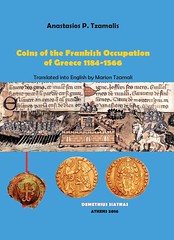
PREV ARTICLE
NEXT ARTICLE
FULL ISSUE
PREV FULL ISSUE
NEW BOOK: COINS OF THE FRANKISH OCCUPATION OF GREECE
David Sundman and Bruce Perdue forwarded this new book announcement from Demetrius Siatras on the medieval Frankish & Venetian coins of Greece. Thanks.
-Editor
This month we present the English translation of the book of A. Tzamalis on the Frankish and Venetian coins of Medieval Greece You can place orders using the PayPal links below or by email at demmath@hotmail.com
Here is the Foreword to the book by Prof. D. M. Metcalf, professor emeritus of Oxford University and former Keeper of the
Heberden Coin Room at the Ashmolean Museum, Oxford.
-Editor
Gustave Schlumberger was a dyed-in-the-wool coin collector. With a keen eye he sifted through the cartons of accumulated coins of the brocanteurs and sellers of antiquities, picking out any varieties that were not already known to him. Eventually his passion and commitment found their full expression in his great work, Numismatique de l'Orient Latin. The varieties were set into the context of what the history books said about the dynasties which ruled during (for example) the Frankish occupation of Greece. Each coin was read as a miniature document: the contribution it made was by its legend, giving the name of the ruler, and the political entity which he governed. That was how numismatists in the nineteenth century understood their chosen task. There were some basic flaws or weaknesses in this approach. In particular, a variety might have been used for a short or a long time; and the differences between one variety and the next might be historically significant, or they might be merely a whim of the die-cutter or a historically meaningless variation. Tasos Tzamalis, a hundred years later, had at his fingertips a far richer and more sophisticated methodology, which had been evolved and tested by generations of mediaeval numismatists. Coins were still — are still — necessarily categorized by their varieties, but the key to understanding their historical context usually comes primarily from the analysis and comparison of coin hoards. Hoards are the anchor points for the correct classification of the coins. In Greece in the last fifty or sixty years, in particular since the 1960s, a good number of large hoards have come to light, and have been studied and recorded more or less fully. The hoards, viewed collectively as an assemblage, can reveal whether a variety was originally plentiful or scarce. Where there was more than one ruler of the same name or with the same initial, they can show that one variety was earlier or later in date than another; and so on. The central importance of hoards is now generally understood, and Tzamalis has been able to build on the contributions and team-work of other scholars, in particular museum curators, who have rescued hoards from dispersal and oblivion, preserving them in publicly funded museums where they are, in theory at least, conveniently accessible to bona fide students. Often, when a new hoard comes to light, it prompts after-thoughts about an earlier find, and students will wish to go back and check the details. Numismatists today have a whole arsenal of techniques which they can apply. The construction of histograms of weights, and their comparison one with another, may be enlightening. Tzamalis has used this method to good effect. The non-destructive chemical analysis of the coins’ alloy in order to estimate their original silver contents can with due care, help to put the varieties in order. But the most powerful of tools is the analysis of style. Whereas any diligent student can construct a histogram, the assessment of style requires not only a perceptive, experienced eye, but also a lot of mental energy and persistence. Tasos Tzamalis has given us an excellent example, where successive princes of Achaia struck deniers tournois with two distinct styles of chattel tournois, maintained in parallel with each other. That led him to recognize that the legend DE CLARENTIA refers not to the mint-place (“of Clarentza”) but to the official monetary standard (denarius Clarentzianus). In ways such as this, the analysis of style can drive a wedge into the otherwise cryptic significance of the basic building blocks — namely, varieties. The hoards, then, can sometimes supply new and better answers to the questions `who’ and `when’. But they are uncertain guides to `where’ — where a variety was minted — because it is always possible that a hoard was put together in one place, but was then carried and eventually concealed elsewhere. Single finds, although they are less glamorous than large hoards, show us more securely what was the composition of the local currency. For Frankish Greece we are exceptionally fortunate in having the rich site finds of stray losses from the archaeological excavations at Old Corinth and in the Athenian Agora. They illustrate the local currency from which they were accidentally lost. Tzamalis makes use of this information too. The sheer numbers of such single finds makes them statistically reliable. Again, there is a need for convenient access by bona fide students who may wish to revisit questions of style. Tasos Tzamalis has achieved a major revision of the numismatic history of Frankish Greece, which fully deserves the wider audience that Marion Tzamali’s translation into English will help to give it.
Leyburn, England
To place an order from the EU Countries & Switzerland:
To place an order from all other Countries:

Wayne Homren, Editor The Numismatic Bibliomania Society is a non-profit organization promoting numismatic literature. See our web site at coinbooks.org. To submit items for publication in The E-Sylum, write to the Editor at this address: whomren@gmail.com To subscribe go to: https://my.binhost.com/lists/listinfo/esylum All Rights Reserved. NBS Home Page Contact the NBS webmaster 
|
